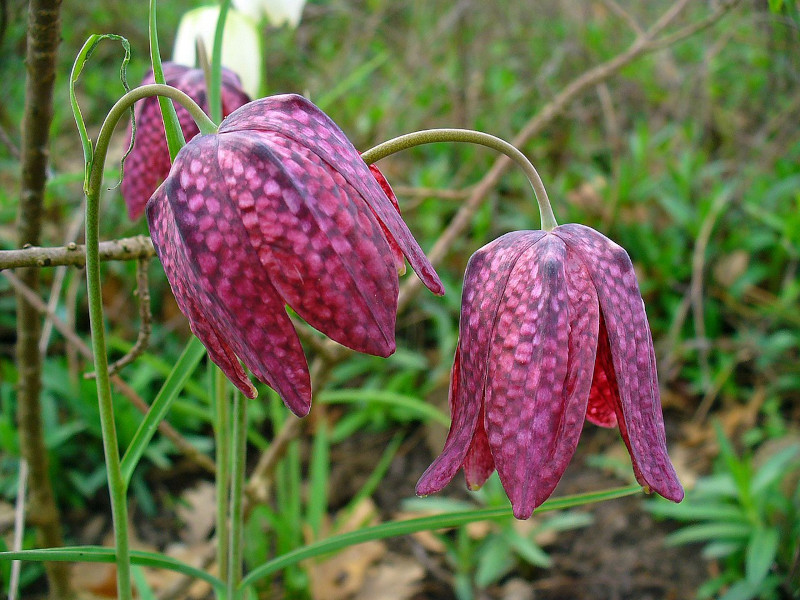
Snake’s Head Fritillary Facts
- The attention-grabbing term of Snake’s Head Fritillary serves as the most frequently used common name for this remarkable plant. It has numerous other titles that it’s known by, however. These include the terms chess flower, leper lily, and Lazarus bell, just to name a few.
- Among scientific professionals, though, it’s typically referred to by its purely official title. But, as very often holds true, that’s a somewhat difficult term for the layperson to pronounce. That’s because the natural marvel holds the complex technical title of Fritillaria meleagris.
- The beautiful Angiosperm received that moniker due to the efforts of Carl Linnaeus. The highly esteemed Swedish botanist accomplished the first official recognition of it as a separate and distinct species. He managed that scientifically noteworthy deed in the year 1753.
- Several of its general names also stem from cultural references, some of them ancient. Snake’s Head, for example, derives from the supposed snake-like appearance of its bulbs. The term leper lily stems from the belief that its shape looks like the bell once carried by many lepers.
- The gorgeous Snake’s Head Fritillary appears to still be present across most of its range. Sadly, though, it’s become uncommon in the wild, though commonly planted in gardens. For the moment, the IUCN has no listing for its on the organization’s Red List of Threatened Species.
- Like many related flora, it faces multiple potential threats to its continued existence as a species. Many of these perils stem directly from the actions of mankind. They include such dangers as habitat loss due to human expansion, and the danger of ongoing climate change.
Related Articles
Snake’s Head Fritillary Physical Description
The mesmerizing Snake’s Head Fritillary certainly qualifies as a creation of Nature that fully earns the appreciation it typically receives from those who encounter it. Yet it does so without the benefit of physical size. That’s true since, in that respect, it’s a small member of its particular Order.
Each example of this true botanical beauty typically produces only a single, though strongly upright stem. These features also generally develop as relatively slender. Exceptional specimens attain heights of up to 15 in (38.1 cm). Most of them, however, remain somewhat shorter than this.
These stems also possess several highly distinctly-shaped shaped leaves. This amazing foliage develops as highly elongated, and each generally curls in upon itself along its length. Both these and the stems from which they spring also usually present as a very light shade of green in color.
Yet it’s undoubtedly the flowers of the Snake’s Head Fritillary that capture the attention of the viewer. Most often these appear singly atop the stem. Nevertheless, as many as 2-3 develop on occasion. This bloom tends to droop from the tip of the structure, and averages 2 in (5 cm) long.
The vast majority of specimens of this wonder display a strongly checkered pattern of various shades of purple. Sometimes white also develops mixed in with the purple. In rare examples, it sometimes even shows pure white. Many thin, reddish-brown veins augment its distinctiveness.
- Kingdom: Plantae
- Phylum: Tracheophytes
- Class: Monocots
- Order: Liliales
- Family: Liliaceae
- Genus: Fritillaria
- Species: F. meleagris
Snake’s Head Fritillary Distribution, Habitat, and Ecology
The stunning Snake’s Head Fritillary evolved as native to a relatively broad swathe of the surface of our globe. The setting for that greater range probably won’t surprise many people, though. This wonder of evolution developed as endemic to most of Europe and western Asia.
Sadly, though, even within that overall zone of habitation, however, it appears in the wild in only highly scattered concentrations. In fact, in many areas it’s presently considered endangered. Countries in which the stunning plant grows natively include Croatia and Sweden, among others.
Like many of its related species found around the world, the amazing flora displays moderately precise requirements regarding its choice of habitats. The remarkable variety of Angiosperm most frequently grows in the wild in regions of either meadows or openings in or near woodlands.
Yet, it nonetheless does sometimes grow in areas of open meadows. In all instances though, it needs the presence of relatively damp soil. Rivers or lakes often lay nearby. The flora also displays a preference for lower altitudes. It’s not known to develop above 2,625 ft (800 m) above sea level.
In the various regions in which the Snake’s Head Fritillary does live naturally, the Tracheophyte fortunately usually develops in moderately large numbers. Pollination occurs due to the actions of multiple locally numerous insects. Its most common pollinator, of course, consists of native bees.
Its beauty does conceal a dangerous secret, however, as so very frequently occurs in evolution. The lovely bulb contains modest amounts of extremely dangerous alkaloids. Due to their presence, few animal species feed on this lovely perennial plant. Nature itself tends to take care of its own!
Species Sharing Its Range
European Mantis
Check out our other articles on 5 Herbaceous Plants of Georgia, Clouded Leopard, Knysna Seahorse, Okenfenokee Swamp, Small Copper, 5 Incredible Indian Ocean Species, Philippine sailfin lizard
